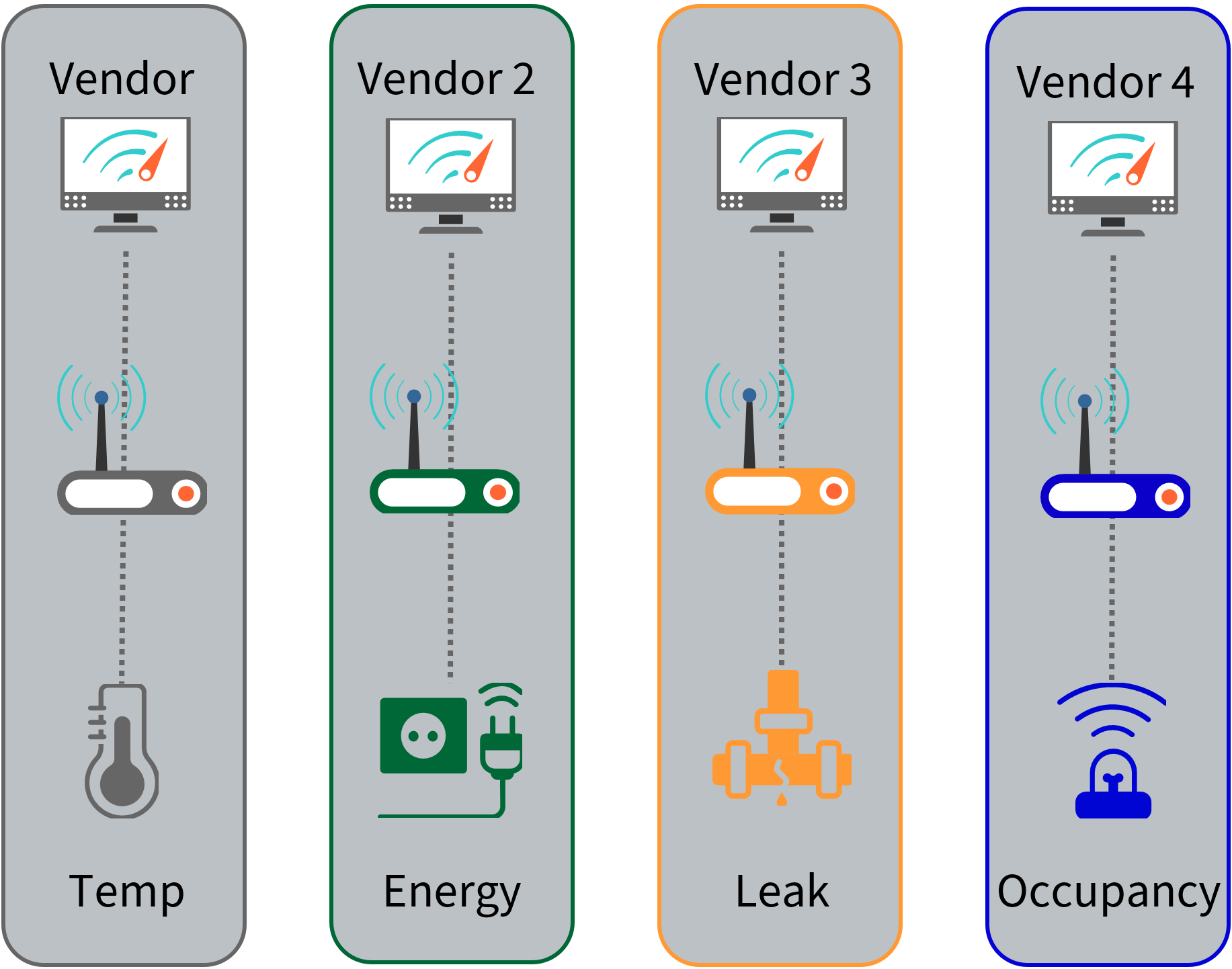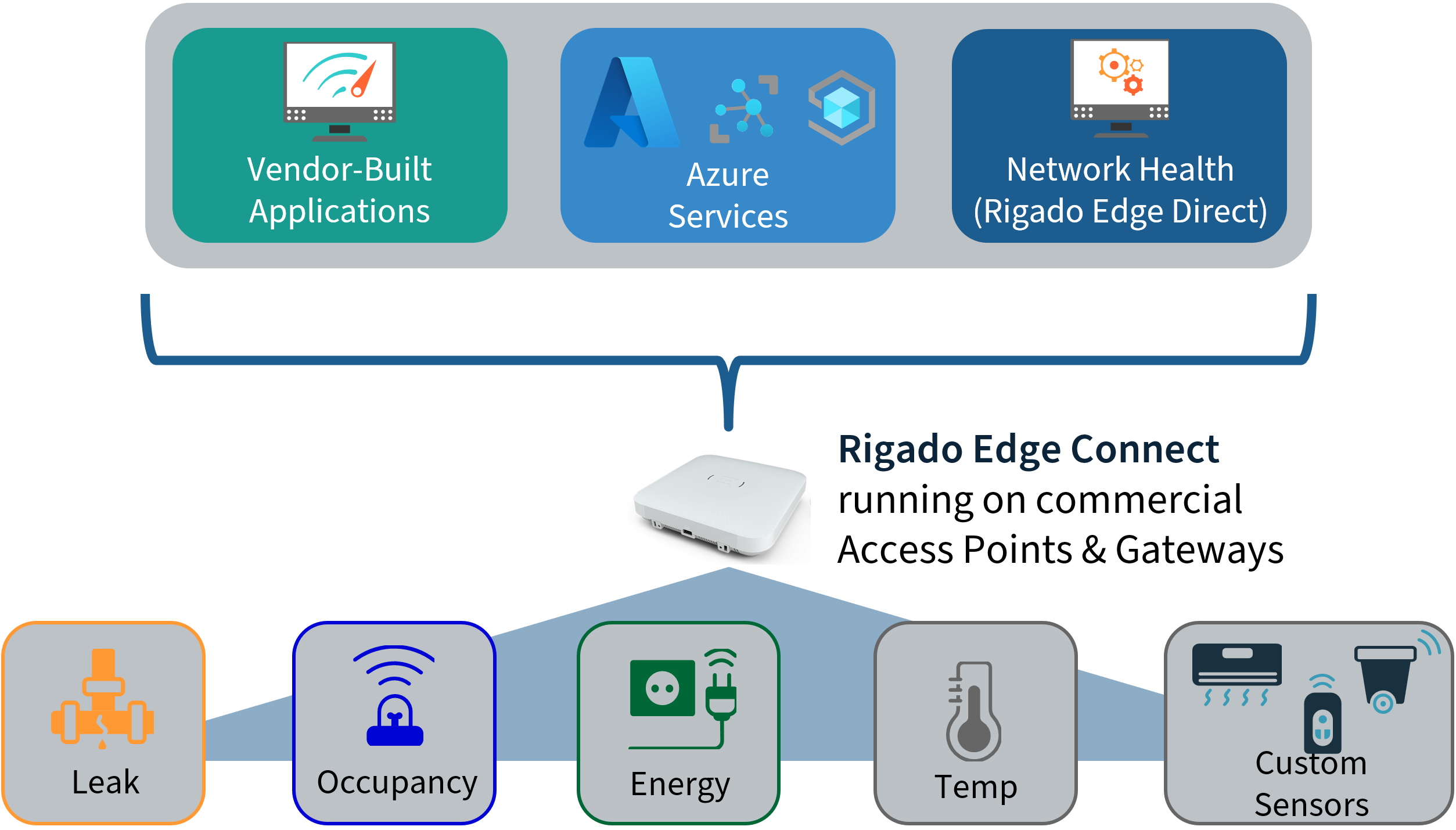Rigado Unified IoT Network
Introduction to the Rigado Unified IoT Network
The Rigado Unified IoT Network is a universal sensor management platform that enables connection to any IoT device to deliver data to cloud applications across shared infrastructure at scale. Rigado's unique approach to connectivity and data management creates a flexible framework to communicate across multiple IoT protocols and standards. This combined with Edge Connect's configuration-based edge processing and data delivery capabilities provides ubiquitous IoT infrastructure.
Why does your Enterprise need a Unified IoT Network?
The Problem
Typical IoT solutions target individual use cases and focus on solving isolated problems, giving the customer a clear decision: either continue using existing processes, or adopt the new product to improve their operations. If a company decides to move forward with an individual IoT solution, there are multiple barriers that now must be solved before the customer can start getting that ROI.
- Lack of Infrastructure - There is nothing installed already that can talk to the IoT solution's proprietary sensors. So, the IoT Solution Provider has to bring in their own IoT Gateway/network adaptor to get their sensor data out to their cloud.
- IT & InfoSec - Information security is an extremely important topic when it comes to technology, especially when it comes to handling data about customers, employees, or business infrastructure. So, the IoT solution needs to be fully audited and approved by IT & InfoSec customer teams. This is a costly and time-consuming process.
- Network planning & Install - All these IoT Gateways/network adapters need to talk to the Internet. This requires a team of people to site plan for sensor coverage, work with IT to get the right network access & assign switch ports, run network cable to all the gateways, and then physically install all the gateways and sensors, then provision them to communicate with the IoT solution cloud. Some IoT Solution Providers use cellular gateways to get around some of this, but these devices still need power. While cellular can simplify setup it trades off some problems for others; gateways still need power, which is now an AC power outlet instead of PoE, and it requires with costly cellular data plans.
- Monitoring & Management - Once an IoT Solution is installed, that's not the end of it. Issues arise in the field and will need to be addressed. Be it a network or power outage or a sensor falling down, someone needs to monitor the solution to ensure it's working and be able to quickly troubleshoot and fix issues to keep it in operation. Most IoT Solution Providers provide web dashboards for customers to use to notify them of issues. So, customers must hire/train teams on the use of this new IoT dashboard or pay to outsource that work.
When customers add up all the above effort, the cost and work become significant. This "barrier to entry" is cited as the top barrier to IoT adoption.
Now take all that above effort and repeat it all again every time a customer wants to solve a new problem with IoT. This results in multiple IoT “shadow networks” being installed which adds cost, creates data silos, and increases network vulnerability. This approach results in a variety of issues, including reduced ROI with multiple cloud SaaS fees, overlapping network deployments, security gaps & inconsistent data, increased installation cost and management.

Multiple Individual IoT Solutions infrastructure
The Solution
While the above problem will always be present when choosing to adopt new IoT solutions, to truly scale what is needed is a single Infrastructure solution that will expand and scale to fit future needs as well.
Rigado's vision delivers a Unified IoT Network delivering IoT sensor data from multiple devices to multiple enterprise applications. The benefits of this approach eliminate single-purpose gateways, provides faster onboarding of new IoT Solutions, a unified sensor network for health monitoring, along with custom apps and standard cloud integrations.

Rigado Unified IoT Network
Extensibility and Flexibility
The IoT Solutions space is diverse and fractured, with multiple wireless protocols and technologies being used across the space. Managing multiple IoT solutions inside a Unified Network requires extensibility to add new IoT radios, adopt new protocols and the flexibility to onboard existing IoT solutions in the way they already communicate.
Rigado accomplishes this using our Edge Connect data management software running at the edge on the network infrastructure. Edge Connect is optimized for IoT protocol and sensor identity translation to ingest data from multiple IoT protocols, transform IoT sensor data and send up to multiple cloud end points simultaneously. Edge Connect runs on Rigado's Cascade Series Gateways designed for 2.4GHz IoT protocols and allows for expansion via USB to other IoT radios. Edge Connect also runs on various enterprise Access Points and Routers to provide IoT connectivity on top of already installed infrastructure with various IoT protocol support.
Edge Connect provides unparalleled flexibility to communicate with and onboard IoT solutions through its configuration-based architecture. Using configuration customers can define how to connect and interpret sensors data, transform the data at the edge and publish data to the cloud or local networks via multiple IP protocols. Edge Connect is the only IoT software built to work with other existing IoT Solutions, instead of requiring the IoT solution to modify their solution to work with Rigado. This greatly reduces the effort to onboard a solution to Rigado's Unified IoT Network.
Secure IoT Network
Rigado takes a security-first approach to network design across all products which has been independently tested and qualified by multiple enterprises including Fortune 500 companies, Hospitals, and Systemically Important Financial Institutions.
Rigado's Edge Connect software for edge sensor connectivity and data processing is run in containment and readback protected from local or remote user access. Edge Connect software contains no solution/sensor/user specific information in its code, all solution specific information is loaded via configuration from Rigado's Edge Direct cloud management platform. Each instance of Edge Connect requires authentication against Edge Direct, and configurations can only be loaded through Edge Direct by authorized users once assigned to the correct Site. Edge Connect does not store or log any sensor data once sent to solution cloud, so no sensitive data is retained in the container.
All Rigado Gateways run Ubuntu Core operating system; a containerized Linux distribution managed by Canonical. Canonical manages security patches including embargoed and zero-day exploit patches to the OS. Rigado leverages OS updates using Canonical's secure store model, which requires Gateways to be uniquely registered and authenticated and can only download updates from the Canonical store via factory provisioned and encrypted endpoints and all updates are signed to ensure authenticity.
Centralized Infrastructure Management
One of the primary "hidden" costs of IoT many new adopters struggle with is the ongoing cost of monitoring and managing the solution to ensure it is operating correctly. Many Enterprise IoT use cases today are primary driven by Operations Technology (OT) and Facilities Management (FM) groups, who are not always well equipped to work with primarily Infrastructure Technology (IT) networks that IoT run on. IT groups are resistant to taking ownership of IoT solutions as the toolsets are fractured and fundamentally different from the Wifi/Network tools typically used. Rolling out even a single IoT solution has significant investment in teams to train up on these tools, and needs to be repeated for each new solution.
Rigado's Edge Direct management portal dramatically reduces customers onboarding and management investment by providing robust and intuitive management tools that manage multiple IoT Solutions. Users can quickly see the health of all installed hardware, including gateways and IoT Devices installed at each Site. Infrastructure managers can also easily get notifications of issues, schedule and roll out system updates and new use cases from a central platform.
Rigado's Edge Direct management cloud platform also provides full API access to integrate all functionality into third party tools, with multiple Access Point provider partners offering built-in integration in their own management tools to manage Edge Connect containers running on their hardware.
Lower Total Cost of Ownership
Adopting new technology is a significant investment for Enterprise businesses today. These efforts often stall during the financial approval process, even before they begin. The challenge lies in justifying both the initial and ongoing costs of building an entirely new infrastructure for just a single use case.
Rigado's approach to a Unified IoT Network dramatically increases that ROI by supporting multiple use cases across different vendors on a single IoT network infrastructure. By combining just two use cases customers can see significant cost savings by reducing/eliminating redundant efforts for:
- Dedicated Solution Gateway hardware purchases
- IT/Infosec qualification and network configuration rollout
- Physical Network infrastructure install hardware, planning, and installation.
- Training/onboarding teams for infrastructure monitoring and management
Combined with the ability to provide future extensibility to onboard new solutions and address new use cases creates a dramatically different ROI story than single point solutions.
Learn More
To learn more about the Rigado Unified IoT Network and how our unique approach to IoT provides unparalleled scalability and increased ROI you can read more here:
Updated 4 months ago
